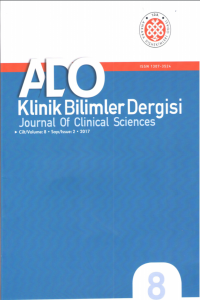Potansiyel Malign Bozukluklar Ve Ağız Kanseri Şüphesi Bulunan Lezyonlara Yaklaşım Ve Diş Hekimlerinin Erken Tanıdaki Rolü
Premalignite, ağız kanseri, erken tanı
Approach To Potentially Malignant Disorders And Suspicious Lesions For Oral Cancer And The Role Of Dentists In Early Diagnosis
Premalignancy, oral cancer, early diagnosis,
___
- Mehrotra R., Mishra S., Singh M. The efficacy of oral brush biopsy with computer-assisted analysis in iden- tifying precancerous and cancerous lesions. Head Neck Oncol. 3:39, 2011.
- Seoane J., Corral-Lizana C., Gonzalez-Mosquera A., Cerero R., Esparza G., Sanz-Cuesta T. The use of cli- nical guidelines for referral of patients with lesions sus- picious for oral cancer may ease early diagnosis and improve education of healthcare professionals. Med. Oral Patol. Oral Cir. Bucal. 16:e864-869, 2011.
- Johnson NW., Jayasekara P., Amarasinghe AA. Squ- amous cell carcinoma and precursor lesions of the oral cavity: epidemiology and aetiology. Periodontol 2000 57:19-37, 2011.
- Groome PA., Rohland SL., Hall SF., Irish J., Mackillop WJ., O’Sullivan B. A population-based study of factors associated with early versus late stage oral cavity can- cer diagnoses. Oral Oncol. 47:642-647, 2011.
- Amagasa T. Oral premalignant lesions. Int. J. Clin. Oncol. 16:1-4, 2011.
- Goodson ML., Thomson PJ.. Management of oral car- cinoma: benefits of early precancerous intervention. Br. J. Oral Maxillofac. Surg. 49:88-91, 2011.
- Oygür T. Ağız kanserleri konusunda toplumdaki far- kındalık düzeyi. ADO Klinik Bilimler Dergisi 3(3):424- 432, 2009.
- Poh CF., Williams PM., Zhang L., Rosin MP. Heads up - a call for dentists to screen for oral cancer. J. Can. Dent. Assoc. 72:413-416, 2006.
- Pentenero M., Navone R., Motta F., Marino R., Gas- sino L., Broccoletti R. Clinical features of microinvasive stage I oral carcinoma. Oral Dis. 17:298-303, 2011.
- Amagasa T., Yamashiro M., Uzawa N. Oral prema- lignant lesions: from a clinical perspective. Int. J. Clin. Oncol. 16:5-14, 2011.
- Kramer IR., Lucas RB., Pindborg JJ., Sobin LH. Defi- nition of leukoplakia and related lesions: an aid to studies on oral precancer. Oral Surg. Oral Med. Oral Pathol. 46:518-539, 1978.
- van der Waal I. Potentially malignant disorders of the oral and oropharyngeal mucosa; terminology, classi- fication and present concepts of management. Oral Oncol. 45:317-323, 2009.
- Warnakulasuriya S., Johnson NW., van der Waal I. Nomenclature and classification of potentially ma- lignant disorders of the oral mucosa. J. Oral Pathol. Med. 36:575-580, 2007.
- Izumo T. Oral premalignant lesions: from the patholo- gical viewpoint. Int. J. Clin. Oncol. 16:15-26, 2011.
- Warnakulasuriya S. Squamous cell carcinoma and precursor lesions: prevention. Periodontol 2000 57:38-50, 2011.
- Villa A., Villa C., Abati S. Oral cancer and oral ery- throplakia: an update and implication for clinicians. Aust. Dent. J. 56:253-256, 2011.
- van der Waal I. Potentially malignant disorders of the oral and oropharyngeal mucosa; present concepts of management. Oral Oncol. 46:423-425, 2010.
- Woolgar JA., Triantafyllou A. Squamous cell carcino- ma and precursor lesions: clinical pathology. Perio- dontol 2000 57:51-72, 2011.
- Regezi JA., Scuibba JJ., Jordan RCK. Oral Pathology Clinical Pathologic Correlations. Elsevier Inc.; 2008.
- Hashibe M., Mathew B., Kuruvilla B., Thomas G., Sankaranarayanan R., Parkin DM. Chewing tobac- co, alcohol, and the risk of erythroplakia. Cancer Epi- demiol Biomarkers Prev. 9:639-645, 2000.
- Reichart PA., Philipsen HP. Oral erythroplakia--a revi- ew. Oral Oncol. 41:551-561, 2005.
- Scheer M., Neugebauer J., Derman A., Fuss J., Drebber U., Zoeller JE. Autofluorescence imaging of potentially malignant mucosa lesions. Oral Surg. Oral Med. Oral Pathol. Oral Radiol. Endod. 111:568-577, 2011.
- Mendes SF., de Oliveira Ramos G., Rivero ER., Modolo F., Grando LJ., Meurer MI. Techniques for precancerous lesion diagnosis. J. Oncol. 2011:326094, 2011
- Cancela-Rodriguez P., Cerero-Lapiedra R., Esparza- Gomez G., Llamas-Martinez S., Warnakulasuriya S. The use of toluidine blue in the detection of pre-malig- nant and malignant oral lesions. J. Oral Pathol. Med 40:300-304, 2011.
- Mehrotra R., Gupta DK. Exciting new advances in oral cancer diagnosis: avenues to early detection. Head Neck Oncol. 3:33, 2011.
- ISSN: 1307-3540
- Yayın Aralığı: Yılda 3 Sayı
- Başlangıç: 2006
- Yayıncı: Ankara Diş Hekimleri Odası
Temporomandibular Düzensizlikler: Tanı ve Tedavi
Canan DAĞ, Nurhan ÖZALP, Mustafa DAĞ
Benay YILDIRIM, Burcu ŞENGÜVEN, Emre BARIŞ, Sibel Elif GÜLTEKİN
Primer Herpetik Gingivostomatit
Derya YILDIRIM, Esin HAŞTAR, H Hüseyin YILMAZ, Ülkem AYDIN
Dört Yarım Çeneyi İçeren Atipik Rejyonel Odontodisplazi
Sıdıka S SOYDAN, Esra ERSÖZ, Kağan DENİZ, Deniz DAĞLIK, Ömer GÜNHAN
Dentin Hassasiyeti, Etiyolojisi ve Tedavisinde Güncel Yaklaşımlar: Hassasiyet Giderici Diş Macunları
Dentin Hassasiyeti: Mekanizmalar, Etiyoloji ve Tedavi Yaklaşımları
Damla DOĞAN, Ç Türksel DÜLGERGİL, Işıl YILDIRIM, Hakan ÇOLAK, M Mustafa HAMİDİ, Ertuğrul ERCAN
Kompozit Rezinler Ve Polimerizasyon Büzülmesi
Merve ULUAKAY, Hüseyin İNAN, Kıvanç YAMANEL, Neslihan ARHUN
Halitozis II: Etyoloji Ve Tedavi
Şehrazat EVİRGEN, Candan S PAKSOY
Dentin Hassasiyeti Tedavisinde Diş Hekimi Tarafından Uygulanan Desensitize Edici Ajanlar
